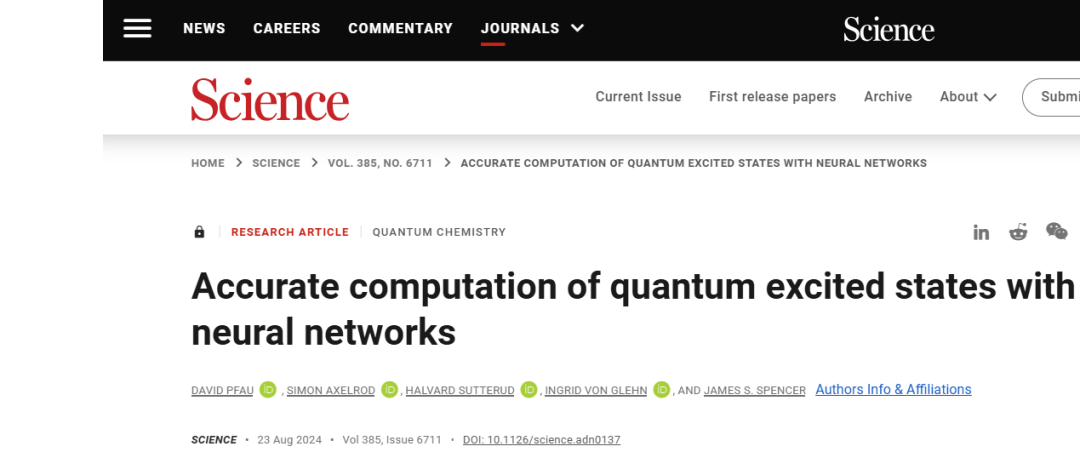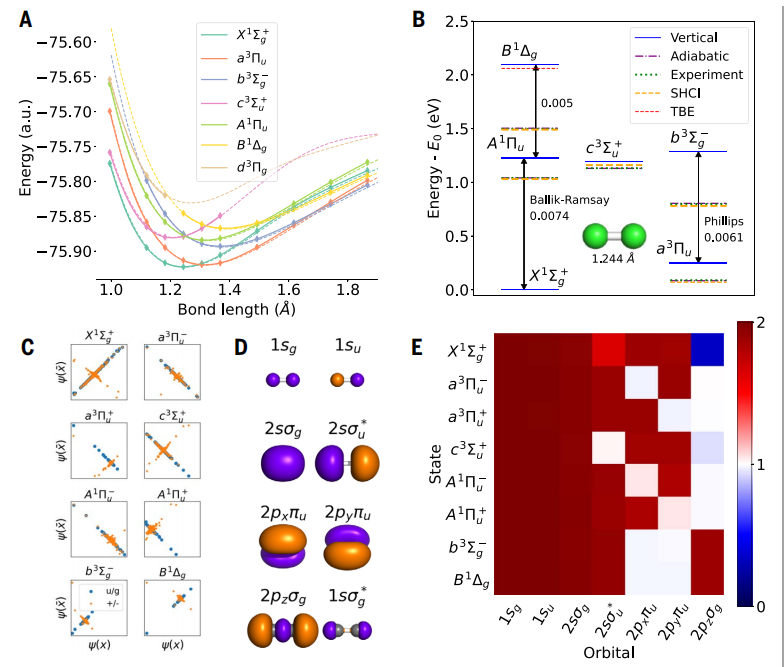 Technology peripherals
Technology peripherals
 AI
AI
 AI solves quantum physics problem for the first time, DeepMind accurately calculates quantum excited states, listed in Science
AI solves quantum physics problem for the first time, DeepMind accurately calculates quantum excited states, listed in Science
AI solves quantum physics problem for the first time, DeepMind accurately calculates quantum excited states, listed in Science

Editor | KX
Previously, the fermion neural network (FermiNet) developed by Google DeepMind researchers is very suitable for modeling the quantum ground state of a large number of electrons.
FermiNet initially focused on the ground state of molecules. But when molecules and materials are stimulated by large amounts of energy, such as when exposed to light or high temperatures, electrons can be kicked into a higher energy state - an excited state.
Excited states are important in fields such as physics and chemistry; however, scalable, accurate, and robust calculations of excited state properties from first principles still face important theoretical challenges.
Now, DeepMind researchers have developed a new method for calculating excited states that is more powerful and versatile than previous methods. The method can be applied to any type of mathematical model, including FermiNet and other neural networks.
The proposed method achieves accurate excited state calculations for many atoms and molecules, is far superior to existing methods of using deep learning to calculate excited state properties (especially on larger systems), and can be applied Various quantum systems.
David Pfau, the first author and corresponding author of the paper, excitedly published "This is the first time that deep learning has accurately solved some of the most difficult problems in quantum physics. We hope to take a new step towards universal quantum simulation of deep learning."

Relevant research titled "Accurate computation of quantum excited states with neural networks" was published on Science !

Paper link: https://www.science.org/doi/abs/10.1126/science.adn0137
Molecular excited states
When molecules and materials are stimulated by large amounts of energy, e.g. Exposed to light or high temperatures, their electrons are kicked into a temporary new structure called an excited state.
The exact amount of energy absorbed and released by a molecule as it transitions between states creates a unique fingerprint for different molecules and materials. This affects the performance of technologies ranging from solar panels and LEDs to semiconductors and photocatalysts. They also play a key role in biological processes involving light, including photosynthesis and vision.
However, this type of fingerprint is extremely difficult to model because the excited electrons are quantum in nature, meaning that their position in the molecule is never certain and can only be represented by probabilities.
FermiNet can produce highly accurate, and in some cases state-of-the-art, ground state energies in a range of atoms and small molecules with a variety of qualitative positron binding properties.
However, FermiNet initially focused on the ground state of molecules. But when molecules and materials are stimulated by large amounts of energy, such as when exposed to light or high temperatures, electrons can be kicked into a higher energy state - an excited state.
Accurately calculating the energy of the excited state is much more difficult than calculating the energy of the ground state. Even gold-standard methods of ground-state chemistry, such as coupled clusters, show tens-fold errors in excited states. While the researchers wanted to extend their work on FermiNet to excited states, existing methods did not perform well enough to make neural networks comparable to state-of-the-art methods.
A more powerful and versatile new method for excited state calculation
DeepMind proposes an algorithm for estimating excited states of quantum systems through variational Monte Carlo. This algorithm has no free parameters and does not require orthogonalization of states. ization, but transform the problem into the problem of finding the ground state of the extended system. Arbitrary observables can be calculated, including off-diagonal expectations such as transition dipole moments.
This method is particularly suitable for neural network analysis. By combining this method with FermiNet and Psiformer ansatz, it is possible to accurately recover the excitation energies and oscillator strengths of a series of molecules.

Illustration: Excited state energies of the first row of atoms from lithium to neon. Results of NES-VMC applied to FermiNet. (Source: paper)
The researchers combined the flexibility of neural networks ansätze with mathematical insight, allowing them to transform the problem of finding the excited state of a system into the problem of finding the ground state of an extended system, which can then be solved using standard VMC. This method is called naturally excited state VMC (NES-VMC).
Linear independence of excited states is automatically imposed via the functional form of ansatz. The energy of each excited state and other observables are obtained by diagonalizing the Hamiltonian expectation value matrix on the singlet ansätze, and these observables can be accumulated at no additional cost.
Entscheidend ist, dass diese Methode keine freien Parameter zum Anpassen und keinen Strafterm zum Erzwingen der Orthogonalisierung hat. Die Forscher untersuchten die Genauigkeit dieses Ansatzes mithilfe zweier unterschiedlicher neuronaler Netzwerkarchitekturen: FermiNet und Psiformer.
Von einzelnen Atomen zu Benzol
Die Forscher testeten ihre Methode an einem Benchmark-System, das von einzelnen Atomen bis zu Molekülen in Benzolgröße reicht. Es wurde bestätigt, dass die Genauigkeit von NES-VMC bei Atomen der ersten Reihe den experimentellen Ergebnissen sehr nahe kommt, und bei einer Reihe kleiner Moleküle werden hochpräzise Energien und Schwingungen erhalten, die mit den besten vorhandenen theoretischen Schätzungen der Gerätestärke vergleichbar sind.

Abbildung: angeregter Zustand des Kohlenstoffdimers. (Quelle: Paper)
Erzielte einen mittleren absoluten Fehler (MAE) von 4 meV bei einem kleinen, komplexen Molekül namens Kohlenstoffdimer, was fünfmal genauer ist als frühere Goldstandardberechnungen.

Abbildung: angeregte Zustände und konische Schnittpunkte von Ethylen. (Quelle: Papier)
Im Fall von Ethylen beschreibt NES-VMC die konischen Schnittpunkte des verdrillten Moleküls korrekt und stimmt gut mit den hochpräzisen Ergebnissen der Multiple Reference Configuration Interaction (MR-CI) überein.

Abbildung: Angeregte Zustände eines größeren Doppelerregungssystems. (Quelle: Papier)
Die Studie berücksichtigte auch fünf anspruchsvolle Systeme mit tiefliegenden Doppelanregungen, darunter mehrere Moleküle der Benzolklasse. In einem System, in dem alle Methoden eine gute Übereinstimmung hinsichtlich der vertikalen Anregungsenergien aufweisen, ist Psiformer in allen Zuständen chemisch genau, einschließlich Butadien, dessen Reihenfolge einige von ihnen ebenfalls seit Jahrzehnten umstritten ist.
Für Tetrazine und Cyclopentadienone, bei denen hochmoderne Berechnungen von vor einigen Jahren bekanntermaßen ungenau sind, stimmen die NES-VMC-Ergebnisse nicht mit der jüngsten hochentwickelten Monte-Carlo-Diffusion (DMC) und vollständig aktiven Raumstörung dritter Ordnung überein Die Berechnung der Theorien (CASPT3) liegt sehr nahe.

Abbildung: angeregter Zustand von Benzol. (Quelle: Papier)
Schließlich wurde auch das Benzolmolekül untersucht, wobei NES-VMC in Kombination mit dem Psiformer-Ansatz im Vergleich zu anderen Methoden, einschließlich des neuronalen Netzwerkansatzes unter Verwendung der Strafkonsistenz, bessere Ergebnisse lieferte. Dies bestätigt nicht nur die mathematische Korrektheit der vorgeschlagenen Methode, sondern zeigt auch, dass neuronale Netze die angeregten Zustände von Molekülen an den Grenzen aktueller Rechenmethoden genau darstellen können.
Wie man es in Zukunft auf die Vielteilchen-Quantenmechanik anwenden kann
NES-VMC ist ein parameterfreies und mathematisch fundiertes Prinzip der Variation angeregter Zustände. Kombiniert man dies mit neuronalen Netzwerkansätzen, kann bei einer Vielzahl von Benchmark-Problemen eine erhebliche Genauigkeit erreicht werden.
Genaue VMC-Methoden für angeregte Zustände von Quantensystemen eröffnen viele Möglichkeiten und erweitern den Anwendungsbereich neuronaler Netzwerkwellenfunktionen erheblich.
Obwohl diese Studie nur elektronische Anregungen molekularer Systeme und neuronale Netzwerkansätze berücksichtigte, ist NES-VMC auf jeden Quanten-Hamiltonianer und jeden Ansatz anwendbar und ermöglicht präzise rechnerische Studien, die das Verständnis der Wissenschaftler für die elektronische Schwingungskopplung und das optische Bandverständnis verbessern können Lücken, Kernphysik und andere herausfordernde Probleme.
Die Forscher sagten: „Wir freuen uns darauf, wie NES-VMC und tiefe neuronale Netze in Zukunft auf die anspruchsvollsten Probleme der Vielteilchen-Quantenmechanik angewendet werden.“ /x.com/pfau/status/1826681648597135464
https://deepmind.google/discover/blog/ferminet-quantum-physics-and-chemistry-from-first-principles/
https:// www.imperial .ac.uk/news/255673/ai-tackles-most-difficult-challenges-quantum/
The above is the detailed content of AI solves quantum physics problem for the first time, DeepMind accurately calculates quantum excited states, listed in Science. For more information, please follow other related articles on the PHP Chinese website!

Hot AI Tools

Undresser.AI Undress
AI-powered app for creating realistic nude photos

AI Clothes Remover
Online AI tool for removing clothes from photos.

Undress AI Tool
Undress images for free

Clothoff.io
AI clothes remover

Video Face Swap
Swap faces in any video effortlessly with our completely free AI face swap tool!

Hot Article

Hot Tools

Notepad++7.3.1
Easy-to-use and free code editor

SublimeText3 Chinese version
Chinese version, very easy to use

Zend Studio 13.0.1
Powerful PHP integrated development environment

Dreamweaver CS6
Visual web development tools

SublimeText3 Mac version
God-level code editing software (SublimeText3)

Hot Topics
 1664
1664
 14
14
 1422
1422
 52
52
 1316
1316
 25
25
 1268
1268
 29
29
 1240
1240
 24
24
 How to understand DMA operations in C?
Apr 28, 2025 pm 10:09 PM
How to understand DMA operations in C?
Apr 28, 2025 pm 10:09 PM
DMA in C refers to DirectMemoryAccess, a direct memory access technology, allowing hardware devices to directly transmit data to memory without CPU intervention. 1) DMA operation is highly dependent on hardware devices and drivers, and the implementation method varies from system to system. 2) Direct access to memory may bring security risks, and the correctness and security of the code must be ensured. 3) DMA can improve performance, but improper use may lead to degradation of system performance. Through practice and learning, we can master the skills of using DMA and maximize its effectiveness in scenarios such as high-speed data transmission and real-time signal processing.
 How to use the chrono library in C?
Apr 28, 2025 pm 10:18 PM
How to use the chrono library in C?
Apr 28, 2025 pm 10:18 PM
Using the chrono library in C can allow you to control time and time intervals more accurately. Let's explore the charm of this library. C's chrono library is part of the standard library, which provides a modern way to deal with time and time intervals. For programmers who have suffered from time.h and ctime, chrono is undoubtedly a boon. It not only improves the readability and maintainability of the code, but also provides higher accuracy and flexibility. Let's start with the basics. The chrono library mainly includes the following key components: std::chrono::system_clock: represents the system clock, used to obtain the current time. std::chron
 Quantitative Exchange Ranking 2025 Top 10 Recommendations for Digital Currency Quantitative Trading APPs
Apr 30, 2025 pm 07:24 PM
Quantitative Exchange Ranking 2025 Top 10 Recommendations for Digital Currency Quantitative Trading APPs
Apr 30, 2025 pm 07:24 PM
The built-in quantization tools on the exchange include: 1. Binance: Provides Binance Futures quantitative module, low handling fees, and supports AI-assisted transactions. 2. OKX (Ouyi): Supports multi-account management and intelligent order routing, and provides institutional-level risk control. The independent quantitative strategy platforms include: 3. 3Commas: drag-and-drop strategy generator, suitable for multi-platform hedging arbitrage. 4. Quadency: Professional-level algorithm strategy library, supporting customized risk thresholds. 5. Pionex: Built-in 16 preset strategy, low transaction fee. Vertical domain tools include: 6. Cryptohopper: cloud-based quantitative platform, supporting 150 technical indicators. 7. Bitsgap:
 How to handle high DPI display in C?
Apr 28, 2025 pm 09:57 PM
How to handle high DPI display in C?
Apr 28, 2025 pm 09:57 PM
Handling high DPI display in C can be achieved through the following steps: 1) Understand DPI and scaling, use the operating system API to obtain DPI information and adjust the graphics output; 2) Handle cross-platform compatibility, use cross-platform graphics libraries such as SDL or Qt; 3) Perform performance optimization, improve performance through cache, hardware acceleration, and dynamic adjustment of the details level; 4) Solve common problems, such as blurred text and interface elements are too small, and solve by correctly applying DPI scaling.
 What is real-time operating system programming in C?
Apr 28, 2025 pm 10:15 PM
What is real-time operating system programming in C?
Apr 28, 2025 pm 10:15 PM
C performs well in real-time operating system (RTOS) programming, providing efficient execution efficiency and precise time management. 1) C Meet the needs of RTOS through direct operation of hardware resources and efficient memory management. 2) Using object-oriented features, C can design a flexible task scheduling system. 3) C supports efficient interrupt processing, but dynamic memory allocation and exception processing must be avoided to ensure real-time. 4) Template programming and inline functions help in performance optimization. 5) In practical applications, C can be used to implement an efficient logging system.
 How to measure thread performance in C?
Apr 28, 2025 pm 10:21 PM
How to measure thread performance in C?
Apr 28, 2025 pm 10:21 PM
Measuring thread performance in C can use the timing tools, performance analysis tools, and custom timers in the standard library. 1. Use the library to measure execution time. 2. Use gprof for performance analysis. The steps include adding the -pg option during compilation, running the program to generate a gmon.out file, and generating a performance report. 3. Use Valgrind's Callgrind module to perform more detailed analysis. The steps include running the program to generate the callgrind.out file and viewing the results using kcachegrind. 4. Custom timers can flexibly measure the execution time of a specific code segment. These methods help to fully understand thread performance and optimize code.
 An efficient way to batch insert data in MySQL
Apr 29, 2025 pm 04:18 PM
An efficient way to batch insert data in MySQL
Apr 29, 2025 pm 04:18 PM
Efficient methods for batch inserting data in MySQL include: 1. Using INSERTINTO...VALUES syntax, 2. Using LOADDATAINFILE command, 3. Using transaction processing, 4. Adjust batch size, 5. Disable indexing, 6. Using INSERTIGNORE or INSERT...ONDUPLICATEKEYUPDATE, these methods can significantly improve database operation efficiency.
 How to use string streams in C?
Apr 28, 2025 pm 09:12 PM
How to use string streams in C?
Apr 28, 2025 pm 09:12 PM
The main steps and precautions for using string streams in C are as follows: 1. Create an output string stream and convert data, such as converting integers into strings. 2. Apply to serialization of complex data structures, such as converting vector into strings. 3. Pay attention to performance issues and avoid frequent use of string streams when processing large amounts of data. You can consider using the append method of std::string. 4. Pay attention to memory management and avoid frequent creation and destruction of string stream objects. You can reuse or use std::stringstream.



